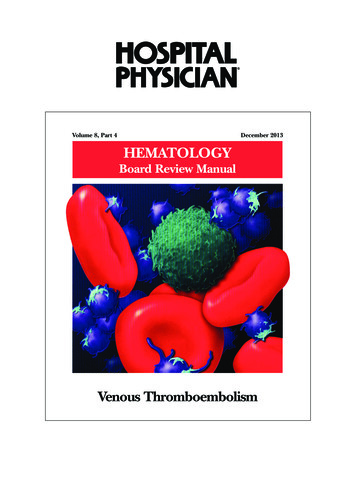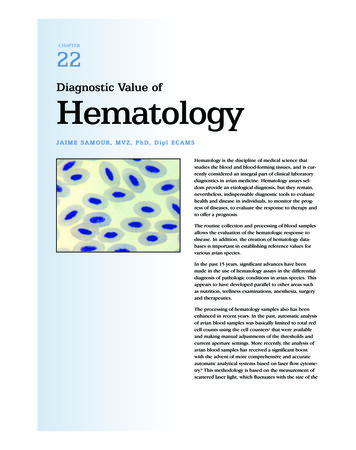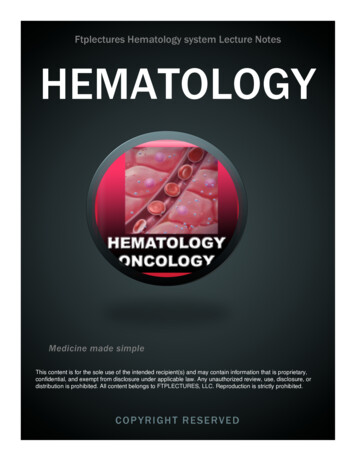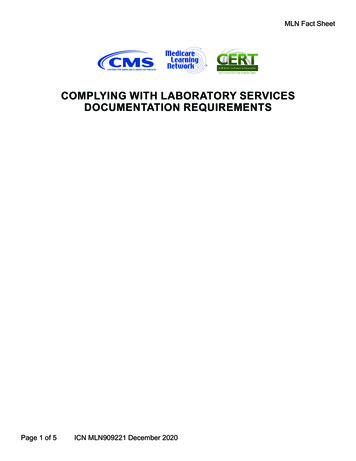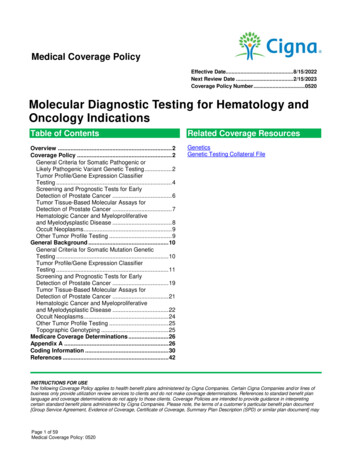
Transcription
Medical Coverage PolicyEffective Date. 8/15/2022Next Review Date . 2/15/2023Coverage Policy Number . 0520Molecular Diagnostic Testing for Hematology andOncology IndicationsTable of ContentsRelated Coverage ResourcesOverview . 2Coverage Policy . 2General Criteria for Somatic Pathogenic orLikely Pathogenic Variant Genetic Testing . 2Tumor Profile/Gene Expression ClassifierTesting . 4Screening and Prognostic Tests for EarlyDetection of Prostate Cancer . 6Tumor Tissue-Based Molecular Assays forDetection of Prostate Cancer . 7Hematologic Cancer and Myeloproliferativeand Myelodysplastic Disease . 8Occult Neoplasms. 9Other Tumor Profile Testing . 9General Background . 10General Criteria for Somatic Mutation GeneticTesting . 10Tumor Profile/Gene Expression ClassifierTesting . 11Screening and Prognostic Tests for EarlyDetection of Prostate Cancer . 19Tumor Tissue-Based Molecular Assays forDetection of Prostate Cancer . 21Hematologic Cancer and Myeloproliferativeand Myelodysplastic Disease . 22Occult Neoplasms. 24Other Tumor Profile Testing . 25Topographic Genotyping . 25Medicare Coverage Determinations . 26Appendix A . 26Coding Information . 30References . 42GeneticsGenetic Testing Collateral FileINSTRUCTIONS FOR USEThe following Coverage Policy applies to health benefit plans administered by Cigna Companies. Certain Cigna Companies and/or lines ofbusiness only provide utilization review services to clients and do not make coverage determinations. References to standard benefit planlanguage and coverage determinations do not apply to those clients. Coverage Policies are intended to provide guidance in interpretingcertain standard benefit plans administered by Cigna Companies. Please note, the terms of a customer’s particular benefit plan document[Group Service Agreement, Evidence of Coverage, Certificate of Coverage, Summary Plan Description (SPD) or similar plan document] mayPage 1 of 59Medical Coverage Policy: 0520
differ significantly from the standard benefit plans upon which these Coverage Policies are based. For example, a customer’s benefit plandocument may contain a specific exclusion related to a topic addressed in a Coverage Policy. In the event of a conflict, a customer’s benefitplan document always supersedes the information in the Coverage Policies. In the absence of a controlling federal or state coveragemandate, benefits are ultimately determined by the terms of the applicable benefit plan document. Coverage determinations in each specificinstance require consideration of 1) the terms of the applicable benefit plan document in effect on the date of service; 2) any applicablelaws/regulations; 3) any relevant collateral source materials including Coverage Policies and; 4) the specific facts of the particularsituation. Each coverage request should be reviewed on its own merits. Medical directors are expected to exercise clinical judgment andhave discretion in making individual coverage determinations. Coverage Policies relate exclusively to the administration of health benefitplans. Coverage Policies are not recommendations for treatment and should never be used as treatment guidelines. In certain markets,delegated vendor guidelines may be used to support medical necessity and other coverage determinations.OverviewThis Coverage Policy addresses molecular diagnostic testing for somatic pathogenic and likely pathogenicvariants for selected hematology and oncology indications. Somatic variants are changes in the DNA of cells thatare not inherited or passed down by blood relatives. They may occur in any cell of the body except the germcells (i.e., egg and sperm).Test methods discussed in the scope of this Coverage Policy include single variant analysis, broad molecularprofiles (e.g., next generation sequencing) and gene expression classifier assays. These tests are used toidentify disease-causing somatic mutations and the biological activity of genes originating in a tumor orhematologic malignancies and can aid in determining the extent or stage of disease, probability of recurrence,appropriate treatment options and how well the disease may respond to treatment in certain clinical scenarios.Coverage PolicyMany benefit plans limit coverage of genetic testing and genetic counseling services. Please refer to theapplicable benefit plan language to determine benefit availability and terms, conditions and limitations ofcoverage for the services discussed in this Coverage Policy.For additional information regarding coverage for specific genetic tests please refer to the GeneticTesting Collateral: Molecular Tests and Biomarkers.General Criteria for Somatic Pathogenic or Likely Pathogenic Variant Genetic TestingMedically NecessaryA tissue-based molecular tumor biomarker, broad molecular profile panel or gene expression classifier(GEC) testing is considered medically necessary when ALL of the following criteria are met: the individual is a candidate for a targeted therapy associated with a specific tumor biomarker(s) ordisease siteresults of testing will directly impact clinical decision makingthe testing method is considered to be scientifically valid and proven to have clinical utility based onprospective evidenceno other tumor biomarker, broad molecular profile panel or gene expression classifier test has beenperformed on this tumor sample for the same indicationANY of the following: indentification of the specific biomarker or risk assessment using a GEC has been validated bythe National Comprehensive Cancer Network (NCCN Guidelines ) as a category 1, 2A or 2Brecommendation for the individual’s tumor type of diseasePage 2 of 59Medical Coverage Policy: 0520
identification of the specific biomarker or use of a GEC has been demonstrated in publishedpeer-reviewed literature to improve diagnosis, management or clinical outcomes for theindividual’s condition being addressed biomarker confirmation is required by a US Federal Drug Administration (FDA)-approved orcleared test as described within the section heading “Indications and Usage” of the FDAapproved prescribing label prior to initiating therapy broad molecular profile panel testing for EITHER of the following:ooadvanced, metastatic solid tumorsANY of the following hematologic malignancies: acute myeloid leukemiamyelodysplastic diseasemyeloproliferative diseasemultiple myelomasystemic mastocytosisTargeted somatic testing for PIK3CA is considered medically necessary when the following criteria aremet: Post-menopausal female or male with advanced or metastatic, ER/PR positive and HER2 negativebreast cancer Patient has progressed on endocrine therapyTargeted molecular testing for NTRK fusions (NTRK1/2/3 fusions) is considered medically necessarywhen the individual has a solid tumor known to respond to treatment with an FDA approved drugtherapy targeting NTRK gene fusions.Liquid biopsy by cell-free DNA laboratory testing methods (e.g., cDNA, ctDNA) is considered medicallynecessary when tissue testing is not available or contraindicated for EITHER of the following: advanced or metastatic solid tumorsbiomarker confirmation is required by an FDA-approved or cleared test as described within the sectionheading “Indications and Usage” of the US FDA-approved prescribing label prior to initiating therapyTesting of bone marrow samples for minimal residual disease (MRD) using high-throughputimmunosequencing (e.g., Clonoseq) is considered medically necessary for ANY of the followingindications or when designated by NCCN as a category 1, 2A or 2B recommendation: multiple myeloma (MM)B-cell acute lymphoblastic leukemia (ALL)chronic lymphoblastic leukemia (CLL)peripheral and cutaneous T-cell lymphoma (TCL)Other testing (e.g., non-high-throughput immunosequencing) for MRD using a validated technologywhen recommended by NCCN Guidelines as a Category 1, 2A, or 2B recommendation is consideredmedically necessary.Not Medically NecessaryPage 3 of 59Medical Coverage Policy: 0520
Molecular testing for hematology and oncology indications is considered not medically necessary if thecriteria described above are not ---Tumor Profile/Gene Expression Classifier TestingMedically NecessaryGene expression classifier testing (GEC) is considered medically necessary when ALL of the followingcriteria are met: individual is a candidate for chemotherapy (i.e., chemotherapy not excluded due to other factors)adjuvant chemotherapy is being considered in a woman and this testing is being ordered to assessrecurrence riskno other GEC has been performed on this tumor sample for the same indicationand the associated criteria are met for ANY of the following indications:Test NameCancer Type and IndicationFor a woman with anatomic stage I or stage 2 invasive breast cancer when ALL of thefollowing criteria are met:MammaPrint 70-Gene BreastCancerRecurrenceAssay (CPTcode81521)Tumor GradeWell differentiatedNodesTumor SizeNone1-33.1-5 cm2.1-5 cmNone1-32.1-5 cmAny sizeNone1-31.1-5 cmAny sizeModerately differentiatedPoorly differentiated orundifferentiated histologic type is ductal, lobular, mixed(ductal/lobular), or metaplastic high clinical risk of recurrence* estrogen receptor (ER)positive/progesterone receptor (PR)positive human epidermal growth factor receptor2 (HER2)-negative up to three positive nodeFor recently diagnosed anatomic stage 1 or stage 2 infiltrating breast cancer when ALL ofthe following criteria are met: Oncotype DX for Early-Stage,Invasive BreastCancer Assay(CPT code81519)Prosigna BreastCancerPrognostic GeneSignature Assay histologic type is ductal, lobular, mixed (ductal/lobular), or metaplastictumor size 0.6-1.0cm and intermediate or high grade (Grade 2 or 3) OR tumor size 1.1-5.0cm any gradeestrogen receptor positive and/or progesterone receptor positiveHER2 receptor negativeNo evidence of distant metastasisEITHER of the following criteria: axillary node status is negative (micrometastasis is no greater than 2.0millimeters) whether the woman is pre- or post-menopausal up to three positive axillary nodes in a post-menopausal womanFor recently diagnosed anatomic stage 1 or stage 2 breast cancer breast cancer when ALLof the following criteria are met:Page 4 of 59Medical Coverage Policy: 0520 histologic type is ductal, lobular, mixed (ductal/lobular), or metaplastic
(PAM50) (CPTCode 81520)EndoPredict Risk Score (CPTcode 81599) tumor size 0.6-1.0cm and intermediate or high grade (Grade 2 or 3) OR tumor size 1.15.0cm any gradeestrogen receptor positive and/or progesterone receptor positiveHER2 receptor negativepostmenopausalNo evidence of distant metastasisAxillary node status is negative (micrometastasis is no greater than 2.0 mm)Breast CancerIndex (BCI) Riskof Recurrenceand ExtendedEndocrineBenefit Test(CPT code81518)Breast Cancer Index (BCI) Risk of Recurrence and Extended Endocrine Benefit Test (CPT code 81518) isconsidered medically necessary for a woman with early stage T1-T3 breast cancer diagnosed within thelast five years when ALL of the following criteria are met: estrogen receptor (ER) positivehuman epidermal growth factor receptor 2 (HER2) negativeno evidence of distant metastasisEITHER of the following: axillary node status is negative (micrometastasis no greater than 2.0 mm) axillary node status is positive (LN with 1-3 positive nodes)no evidence of cancer at the time of testingtest results will be used to determine treatment management of the individual for extended endocrinetherapy after completion of at least four years of endocrine therapyExperimental/Investigational/UnprovenGene expression testing for breast cancer is considered experimental, investigational or unproven if thecriteria described above are not met.OncotypeDx Breast DCIS Score test is considered experimental, investigational or unproven.Adhesive patch gene expression assay for pigmented skin lesions is considered experimental,investigational or --------Serum Proteomic TestingSerum proteomic testing (i.e., Veristrat) is considered medically necessary for advanced non-small celllung cancer to determine second-line treatment when ALL of the following criteria are met: EGFR variant mutation status is wild-type (i.e., no pathogenic or likely pathogenic variant detected) orunknownindividual has failed first-line systemic chemotherapytest results will be used to decide whether to proceed with erlotinib (Tarceva ) therapyPage 5 of 59Medical Coverage Policy: 0520
Serum proteomic testing is considered experimental, investigational or unproven if the criteria describedabove are not ---Circulating Tumor Cells TestingMedically NecessaryAR-V7 testing from circulating tumor cells is considered medically necessary for a male with metastaticcastrate resistant prostate cancer (mCRPC) considering second line therapy when BOTH of the followingcriteria are met: progression on androgen receptor–signaling inhibitor (ARSi) therapy (i.e., enzalutamide (Xtandi),abiraterone (Zytiga))nuclear expression of AR-V7 will be assessed to guide subsequent therapeutic decision makingExperimental, Investigational or UnprovenDetection of circulating whole tumor cells for any other indication is considered experimental,investigational or --------Screening and Prognostic Tests for Early Detection of Prostate CancerMedically NecessaryThe following prostate cancer screening and prognostic genetic tests are considered medicallynecessary for the early detection of prostate cancer when results will impact medical management andthe associated criteria are met:Name4K Score TestPercent free PSAProstate Health Index(PHI) Cancer Type and IndicationEITHER PSA 3.0ng/mL with or without previous benign prostate biopsy OR suspiciousdigital rectal exam (DRE)OR PSA 3.0ng/mL and previous benign prostate biopsy or focal high gradeprostatic intraepithelial neoplasia (PIN)When EITHER of the following criteria is met:Select MDxExoDXConfirmMDx forProstate CancerProgensa PCA3 AssayPage 6 of 59Medical Coverage Policy: 0520 PSA 3.0 ng/mL with or without previous benign prostate biopsysuspicious digital rectal exam (DRE)When BOTH of the following criteria are met: PSA 3.0 ng/mLprevious benign prostate biopsy or focal high grade prostatic intraepithelialneoplasia (PIN)
Experimental, Investigational and UnprovenProstate cancer screening and prognostic testing is considered experimental, investigational orunproven if the criteria described above are not ---Tumor Tissue-Based Molecular Assays for Detection of Prostate CancerMedically NecessaryThe following tumor-based molecular assays for detection of prostate cancer are considered medicallynecessary when the associated criteria are met:Test NameDecipher ProstateCancer ClassifierAssayCancer Type and IndicationANY of the following: PSA persistence after radical prostatectomy (i.e., failure of PSA to fall toundetectable levels after radical prostatectomy) PSA recurrence after radical prostatectomy (i.e., undetectable PSA afterradical prostatectomy with a subsequent detectable PSA that increases ontwo or more determinations Post-prostate biopsy when the individual is a candidate for activesurveillance or definitive therapyfor ANY of the following prostate cancer risk types: low-risk* favorable intermediate-risk* unfavorable intermediate-risk* high-risk*Post prostate biopsy when the individual is a candidate for active surveillance ordefinitive therapy for ANY of the following risk types:Prolaris ProstateCancer Test low-risk*favorable intermediate-risk*unfavorable intermediate-risk*high-risk*OncotypeDx Genomic ProstateScorePost prostate biopsy for low risk* or favorable intermediate-risk* prostate cancerwhen the individual is a candidate for active surveillance or definitive therapyProMark ProteomicPrognostic TestPost prostate biopsy for low risk* or favorable intermediate-risk* prostate cancerwhen the individual is a candidate for active surveillance or definitive therapy*Low-risk: T1-T2a disease AND Gleason score 6/grade group 1 AND PSA 10ng/mLFavorable intermediate-risk: T2b-T2c disease OR Gleason score 3 4 7/grade group 2 OR PSA 10-20 ng/mLAND percentage of positive biopsy cores 50%Unfavorable intermediate-risk: One or more of the following: 2 or 3 intermediate risk factors, grade group 3, 50% biopsy cores positive (e.g., 6/12 cores)High-risk: no very-high-risk features and has exactly one high-risk feature: cT3a OR Grade Group 4 or GradeGroup 5 OR PSA 20 ng/mLPage 7 of 59Medical Coverage Policy: 0520
Not Medically NecessaryTumor-based molecular assays for prostate cancer are considered not medically necessary if the criteriadescribed above are not --------------------Hematologic Cancer and Myeloproliferative and Myelodysplastic DiseaseMedically NecessaryPolycythemia Vera (PV)Genetic testing for JAK2 common variants (CPT code 81270, 81279), MPL common variants (CPT code81338, 81339), and CALR exon 9 common variants (CPT code 81219) is considered medically necessaryfor the diagnosis of polycythemia vera (PV) when BOTH of the following criteria are met: genetic testing would impact medical management of the individual being testedONE of the following: hemoglobin 16.5 g/dL in men, 16.0 g/dL in womenhematocrit 49% in men, 48% in womenincreased red cell mass (RCM) more than 25% above mean normal predicted ----Essential ThrombocythemiaGenetic testing for JAK2 common variants (CPT code 81270, 81279), MPL common variants (CPT code81338, 81339), and CALR exon 9 common variants (CPT code 81219) is considered medically necessaryfor the diagnosis of essential thrombocythemia or thrombocytosis (ET) when BOTH of the followingcriteria are met: results will impact medical managementEITHER of the following criteria are met: platelet count 450 x 10 9/L bone marrow biopsy showing proliferation mainly of the megakaryocyte lineage with increasednumbers of enlarged, mature megakaryocytes with hyperlobulated nuclei. No significantincrease or left shift in neutrophil granulopoiesis or erythropoiesis and very rarely minor (grade1) increase in reticulin -----Primary Myelofibrosis (PMF)Genetic testing for JAK2 common variants (CPT code 81270, 81279), MPL common variants (CPT code81338, 81339), and CALR exon 9 common variants (CPT code 81219) is considered medically necessaryfor the diagnosis of primary myelofibrosis (PMF) when BOTH of the following criteria are met: results will impact medical management.primary myelofibrosis is suspected but not confirmed, based on results of conventional testing.Page 8 of 59Medical Coverage Policy: 0520
ASXL1, EZH2, TET2, IDH1/IDH2, SRSF2, and SF3B1 testing is considered medically necessary for thediagnosis of primary myelofibrosis (PMF) when ALL of the following criteria are met: primary myelofibrosis is confirmed or suspected based on clinical findingsabove criteria are metresults will impact medical management.bone marrow findings of megakaryocytic proliferation and atypia, without reticulin fibrosis grade 1,accompanied by increased age-adjusted bone marrow cellularity, granulocytic proliferation, and often,decreased erythropoiesistesting will be completed on bone marrow sampleJAK2, CALR and MPL mutation analysis waspreviously completed and was -------Chronic Myelogenous Leukemia (CML) and Philadelphia Chromosome Positive (PH )Acute Lymphoblastic Leukemia (ALL)BCR-ABL T315-I mutation testing (81401, 81170) is considered medically necessary in individuals withchronic myelogenous leukemia (CML) or Philadelphia chromosome positive (Ph ) acute lymphoblasticleukemia (ALL) when ANY of the following are met: inadequate initial response to tyrosine kinase inhibitor therapy (i.e., failure to achieve completehematological response at 3 months, minimal cytogenetic response at 6 months or major cytogeneticresponse at 12 months)loss of response to tyrosine kinase inhibitor therapy (i.e., hematologic relapse, cytogenetic relapse, lossof major molecular response [MMR])progression to accelerated or blast phase CML while on tyrosine kinase inhibitor ----Occult NeoplasmsMedically NecessaryThe following paraneoplastic (onconeural) antibodies are considered medically necessary for theevaluation of neurological symptoms when the diagnosis remains uncertain following conventionalwork-up and an occult neoplasm is suspected: anti-Hu (ANNA-1 [antineuronal nuclear autoantibodies-1]) anti-Yo (PCA-1 [Purkinje cell antibody-1]) anti-CV2 (CRMP5 [collapsing mediator response protein5]) anti-Ri (ANNA-2) anti-MA2 -Other Tumor Profile aphic genotyping for any indication is considered experimental, investigational or unproven.Page 9 of 59Medical Coverage Policy: 0520
General BackgroundFor additional information regarding specific genetic tests please refer to the Genetic Testing Collateral:Molecular Tests and Biomarkers.General Criteria for Somatic Mutation Genetic TestingSomatic mutations are changes in the DNA of a cell that may occur in any cell of the body except the germ cells(i.e., egg and sperm). Somatic mutations differ from germline mutations, which are passed down by bloodrelatives; somatic mutations are not inherited. The genetic tests described in this Coverage Policy are used toidentify disease-causing somatic mutations or the biological activity of genes originating in a tumor orhematologic malignancy.Tumor markers, also known as biomarkers are substances that are produced by certain cells of the body inresponse to cancer or some noncancerous conditions. Although most tumor markers are made by normal cellsas well as by cancer cells, they are produced at much higher levels in cancerous conditions. They can be foundin the blood, urine, stool, tumor tissue, or other tissues or bodily fluids of some patients with cancer (NationalCancer Institute [NCI], 2022. Tumor marker levels may be useful in determining the extent or stage of disease orrecurrence, determining the most effective treatment for a specific disease and how well the disease will respondto treatment.Published peer-reviewed evidence and professional society/organizational consensus guidelines support testingfor certain tumor markers for the screening, staging, diagnosis and management of some types of cancer.However, for other tumor markers there is insufficient evidence to establish clinical utility for informing onimprovement of health outcomes.To have clinical utility the specific gene or gene biomarker for which testing has been requested, or geneexpression classifier assay should be demonstrated in the published, peer-reviewed scientific literature in theform of prospective clinical trial data to improve the diagnosis, management, or clinical outcomes for theindividual’s tumor type or disease when the individual is a candidate for a related therapy. The identification ofthe gene or biomarker should also be required to initiate a related therapy that has been validated by the NCCNas a Category 1, 2A or 2B Level of Evidence and Consensus recommendation as a standard of care. The NCCNrecommendations are defined as: Category 1: Based upon high-level evidence there is uniform NCCNconsensus that the intervention is appropriate, Category 2A: Based upon lower-level evidence there is uniformNCCN consensus that the intervention is appropriate, Category 2B: Based upon lower-level evidence there isNCCN consensus that the intervention is appropriate and Category 3: Based upon any level of evidence, there ismajor NCCN disagreement that the intervention is appropriate.Multigene panels may also provide important information regarding an individual’s tumor type to direct proventherapy or support management changes for hematology-oncology indications. These tests may be clinicallyuseful when sequential testing of individual genes or biomarkers is not feasible because of limited tissueavailability, or when urgent treatment decisions are pending and sequential testing would result in a prolongedtesting schedule.There is insufficient evidence in the published, peer-reviewed scientific literature to support molecular testingwhen the requested gene(s) or biomarker(s) is(are) correlated with a known therapy, but that therapy has notbeen validated in prospective clinical trials for the specific tumor type or disease site.Broad Molecular Profile TestingBroad molecular profile tests, also known as molecular profiling and comprehensive genome profiling panels arelarge multigene tests which assess multiple genetic alterations simultaneously in a solid tumor. Severallaboratory methods may be used to assess the tumor; however, next generation sequencing techniques aremost commonly used. Broad molecular tests can identify alterations to base substitutions (substitution of anPage 10 of 59Medical Coverage Policy: 0520
amino acid), insertions and deletions (amino acids are added or removed from DNA), copy number alterations(sections of DNA are repeated) and rearrangements (amino acids are rearranged in a different order). Broadmolecular profile testing may be used with the goal of identifying mutations of interest for which drug therapymay be available or for enrollment in a clinical trial (NCCN, 2022). Limitations to testing include testing for morealterations than have been identified for a specific type of cancer and the identification of variations of unknownsignificance. Nonetheless, such testing is supported by published professional society guidelines, including fromthe NCCN (2022) as a key component of care for a number of advanced, metastatic, refractory and recurrentcancers.Biopsy Testing MethodsA biopsy is used as a diagnostic and monitoring tool to identify abnormalities in tissue or blood. A traditionaltissue biopsy is used to sample and analyze a solid biological specimen. Tissue biopsy remains the goldstandard for the confirmation and diagnosis of disease, including various cancers. Limitations include patient riskdue the invasive nature of the test and limited availability of the tissue sample.There is increasing use of plasma cell-free DNA testing, also known as a liquid biopsy, which is used to sampleand analyze nucleic acids in peripheral circulation, most commonly in plasma. At present there are no standardsfor analytical performance and no guidelines exist for regarding the recommended performance characteristics.Cell-free DNA testing has a high specificity rate but limitations include a compromised sensitivity with up to a30% false-negative rate. Such testing may also identify alterations that are unrelated to a lesion of interest(NCCN, 2022). Nonetheless, the use of cell-free DNA testing may be considered appropriate when a patient ismedically unfit for invasive tissue sampling or there is insufficient material for analysis in advanced (III or IV),metastatic, recurrent or refractory solid cancers.Testing for Minimal Residual DiseaseMinimal residual disease refers to the presence of leukemic cells below the threshold of detection byconventional morphologic methods. Patients who achieve complete response by morphologic assessment alonecan harbor leukemic cells in the
The following Coverage Policy applies to health benefit plans administered by Cigna Companies. Certain Cigna Companies and/or lines of business only provide utilization review services to clients and do not make coverage determinations. References to standard benefit plan language and coverage determinations do not apply to those clients.
